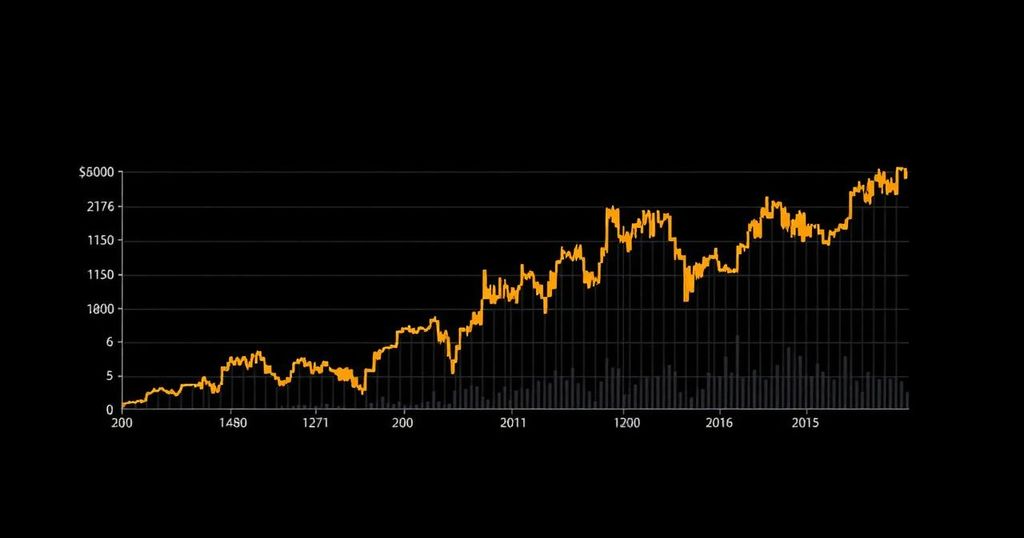Bitcoin Price Volatility Amidst Economic Uncertainty and Regulatory Pressures
Summary
Bitcoin’s price remains volatile, hovering around $62,000 amidst potential Federal Reserve interest rate cuts and weak economic data, particularly from China. Significant inflows into Bitcoin ETFs and purchases by MicroStrategy have supported its momentum, yet regulatory pressures and recent selling activity by long-term holders have dampened investor sentiment.
Bitcoin has experienced volatility as it hovers below the critical threshold of $62,000, amidst shifting economic conditions and market expectations. Analysts have pointed towards a decline in the US dollar, paired with a record high for gold, as contributors to Bitcoin’s recent price increase. Furthermore, significant capital inflows into Bitcoin spot exchange-traded funds (ETFs), along with a notable purchase by MicroStrategy, are recognized as factors that have bolstered its momentum as of September 13. However, caution prevails among bullish traders, primarily due to the anticipation of a potential Federal Reserve interest rate cut that could influence their trading strategies. A projected reduction in interest rates at the forthcoming Federal Open Market Committee (FOMC) meeting on September 18 might favor risk-on assets, yet current investor focus on equities could diminish Bitcoin’s upward momentum. Despite strong performances from large technology firms, a more conservative rate cut might adversely affect market dynamics due to increased borrowing costs, possibly leading to restrained economic growth. In parallel, stagnant growth indicators from China add another layer of uncertainty for Bitcoin. The nation reported a mere 2.1% increase in retail sales for August, a decline from previous performance, while industrial production also slowed. Eswar Prasad, a professor at Cornell University, articulated the economic concerns, stating, “Both the long term issues related to property prices and so on, and the short term issues related to domestic demand […] have not been doing well at all.” He suggests the outlook for China’s economy has entered a precarious state. Within this context, investor sentiment has also been impacted by noteworthy events in the cryptocurrency market. A significant transaction involving dormant Bitcoin, which had been idle for nine years, raised concerns about potential selling activity by long-term holders. Additionally, regulatory pressures have escalated, particularly with the US Securities and Exchange Commission (SEC) expanding its lawsuit against Binance, leading to heightened regulatory scrutiny that has diminished investor confidence in Bitcoin. In summary, while Bitcoin is navigating a challenging economic landscape with considerable risks, it still stands as a potential refuge against inflationary pressures stemming from expansive monetary policies. Yet, amidst uncertainties, investors are likely to seek the stability of cash and government bonds over riskier assets.
The current economic climate features a convergence of several critical factors impacting Bitcoin’s performance. The anticipated interest rate cut by the Federal Reserve aims to stimulate the economy; however, it could potentially alter the dynamics of risk-on trading in cryptocurrencies. Concurrently, the economic recovery of China is sluggish, heightening concerns about global economic stability. Moreover, developments within the regulatory landscape, particularly concerning major exchanges like Binance, have further complicated the investment environment. These elements create a substantial backdrop against which Bitcoin’s price volatility can be assessed.
In conclusion, Bitcoin’s price remains precarious as it grapples with external economic pressures and internal market dynamics. Weakening economic indicators from China and potential regulatory hurdles present notable challenges. However, the cryptocurrency continues to exhibit resilience, emerging as a potential hedge against traditional financial instability. Investors must navigate these complexities carefully, balancing risks with opportunities as they consider their positions in the market.
Original Source: cointelegraph.com








Post Comment